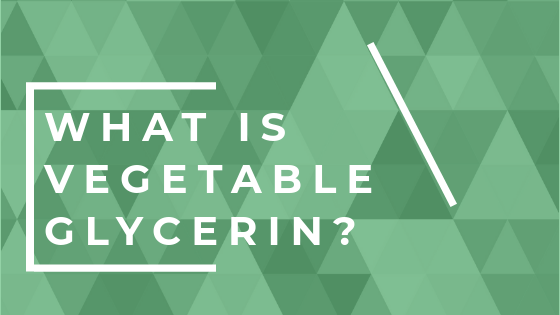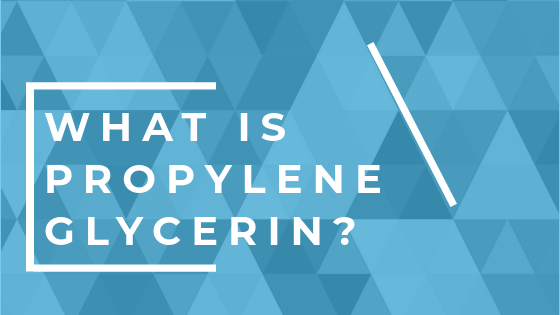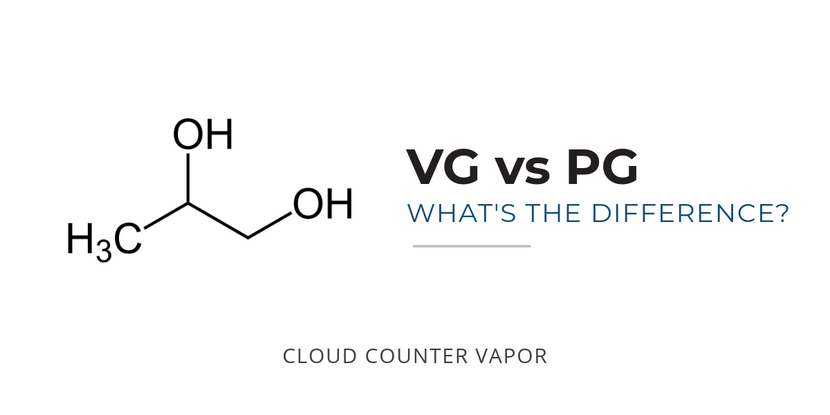VG vs PG - What's The Difference In Your Vape Juice Ratios?
The first thing you need to invest in when getting into vaping is the right pieces of equipment to suit your vaping style. Usually this involves first pondering over the hundreds of potential flavor selections tirelessly until you've finally selected the perfect one.
But what makes those flavors stand out, and what makes your chosen device the perfect choice for your preferred juices? And what's all of this talk about VG/PG percentages and ratios?
There’s a lot to consider, but don’t worry. Once you understand how a juice is made, you’ll understand what to look for.
First you need to understand that different juices pg/vg ratios require different types of devices.
The various e-liquids are crafted with different ingredients and different balances of the primary chemicals used to make all juices: vegetable glycerin (VG) and propylene glycol (PG). The relationship between these two key ingredients make all the difference in the world when it comes to the intensity of each hit, the vapor density, and the thickness/fullness of the flavor.
These ingredients serve as the base for every e-juice you’ll find out there, so you don’t want to overlook this important characteristic of the vape juices and device combos you choose.
But let's start out with defining exactly, what are VG and PG?

What Is Vegetable Glycerin?
Vegetable glycerin is relatively simple to understand. It’s made from organic plant oils, most often from commonly-known sources like soy, coconut oil, and palm oil. Besides vape juices, vegetable glycerin is known for a variety of popular household items such as cosmetics, shampoos, lotions, and even some foods.
VG has a thicker body to it than PG, and tends to make for more luscious and full flavors (although pure VG is actually flavorless!) Besides the “all-natural” appeal of VG blends, they also produce richer, milkier vapor clouds. As a result, high-quality VG blends are eminently sought after among vapor trick enthusiasts.
High-VG blends tend to have a very small throat hit, which is a characteristic that many newer vapers seek, not being used to the impact on their throat. Also, veterans who are trying to get away from the “smoking feel” of vaping often find that using high-VG blends helps the vaping experience feel much more smooth. Even those who aren’t irritated by the presence of PG tend to have a liking for high-VG blends, since they are an easier overall experience.

What Is Propylene Glycerin?
PG, on the other hand, is much less viscous, and it hits the throat a little bit more than VG-heavy juices. Plus, some vapers are sensitive to PG and can’t consume very much of it at once (or find that they don’t enjoy consuming any at all!) It’s a rare response, but some vapers report an almost allergy-like reaction with too much PG, and thus can’t use it at all. And even for many of these vapers, blends containing ratios as little as 20% PG or less will often not cause any unwanted effects. For these folks, higher-VG blends are going to be their best friend.
PG does, however, has the advantage of better absorption into wicks, and a lower temperature threshold for vaporizing. Since PG is much thinner than VG, it seeps into a dried wick much more quickly. When you pull from your vape, the juice in the soaked wick atomizes into delicious vapor, and the tank drips more juice down into the wick. VG can sometimes be so viscous that it takes several seconds to drip down. If you hit your vape while the wick is dry, you’ll get a nasty puff that’s really off-taste. Depending on the type of tank you have, this may be a significant factor in selecting a juice (sub-ohm tanks tend to avoid this problem!). But when using PG based juices, this worry can be a thing of the past.
Plenty of juice makers, especially in the earlier days, would produce juices comprised solely of one or the other ingredient, depending on the experience they wanted their product to invoke. As time went on and the market became more competitive, manufacturers realized they could enhance their product lines by mixing the two to combine the best of both worlds.
Thus, while vegetable glycerin is the “star of the show,” in a sense, contributing to the flavor profile and the mouthfeel, the propylene glycol is the blueprint that helps give the juice that “just right” amount of impact and functionality. The balance between the two components is what makes each e-liquid unique, and thus a harmonious relationship between them is essential to a high-quality finished product.
Choosing The Right VG/PG Ratio
If you find yourself asking how to choose the best VG/PG ratio, you’re not alone - this is one of the most common questions we get in the shop. The only way to really know what VG/PG ratio truly works for you and gives you the experience you want to have is to try them out for yourself.
The best way to experiment, if you have the means, is to just mix your own juices and see what ratios you tend to like the best. Plus, this gives you free reign to create any kind of juice you want to try! Plus, each vaporizer device tends to work a little bit differently, so certain ratios may be more suited to the device you like to use. You’ll find this over time as you explore different juices, keeping your device thoroughly cleaned between each refill.
You’ll probably also notice that different flavor profiles tend to be better suited to specific ratios. Play around with different categories of flavors and you’ll notice certain ratios for your fruitier flavors and certain ratios for your sugary flavors, etc etc.
Another consideration is nicotine availability; you’re just not going to be able to pack as high a concentration of nicotine into VG-heavy blends as you might want. So, you’ll have to compensate with more PG, and thus might experience a big shift in the flavor and character of your juice.
Plus, while VG-heavy blends are certainly popular for a reason, they often require a longer steeping time than PG blends, meaning you’re waiting around longer to enjoy the juice you’re so eager to try. And, while high-VG blends certainly pack a lot of flavor, they can’t offer quite the diversity and complexity within an individual blend that a higher-PG e-liquid can.
So, while we love to encourage creativity and hear about the different creative DIY blends that our fans have concocted, you’re probably better off buying a juice or two from the folks who make a living producing e-liquids. Let’s explore some of the most popular VG/PG ratios and their attributes.
Popular VG/PG Ratios and their Characteristics
Here’s a quick summary of the commonly-found VG/PG ratios juice makers use today. We’ve also included notes about pure-VG and pure-PG juices to help give you an idea of the power of each ingredient.
Pure PG (100%, Max PG) - While this particular “ratio” has fallen by the wayside in recent history, it certainly had its place in the vaping community. While a strong throat hit turns off many newer vapers, some vastly prefer to feel the experience rather than simply taste it. Pure PG juices offered the strongest throat hit, and serves as the best delivery system for more fine-tuned flavors. But it certainly doesn’t produce that much vapor, a sore disappointment for those folks who like to vape for the aesthetic.
Pure VG (100%, Max VG) - Max VG hasn’t fallen out of favor nearly as much as max PG, as it serves as an excellent replacement product for those vapers who are more sensitive to PG. Plus, it’s among the most popular choices for competitive vapers, as it makes it much easier to puff thick, satisfying clouds. It doesn’t hit the throat, either, meaning the vape trick enthusiasts and “cloud chasers” can play with their vapor all day and not worry as much about exhausting their throat.
80/20 VG/PG (80%VG, Ultra-high VG) - As you can probably imagine, this style isn’t a far-cry from the pure VG juices discussed above. The glycerin starts to embolden the sweetness of the juice, while detracting a bit from the subtler flavors that make up the overall taste. While these juices offer a very minimal throat hit, and are thus accessible to a range of vapers, they also have a tendency to jam up your coils a lot more quickly, as the high VG ratio is so viscous. Make sure you have a device that can handle the heavier fluids, and that you clean your device regularly.
70/30 VG/PG (70% VG, High-VG) - This is possibly the most commonly-used ratio among juice manufacturers today, as it strikes a balance that resonates with many vapers. 70/30 juices tend to still pack a lot of flavor without too much overbearing sweetness. They give you a minor throat hit so you can easily moderate your intake. Plus, they still give you relatively impressive and milky clouds, making for a satisfying and well-rounded experience.
50/50 VG/PG (50% split, half-n-half) - Obviously, an even mixture is a great starting place for exploring new flavors and combinations. You don’t always know exactly which direction you want to go with a juice, so you start from the equilibrium and work in one direction or the other. This used to be the dominant ratio in the marketplace, but as of late it’s been eclipsed by the popularity of 70/30 high-VG blends. These blends still give you a decent amount of vapor production on the exhale without too much power on the inhale.
30/70 VG/PG (70% PG, High PG) - Down here, we’re starting to get into the more intense vaping experiences, but with the more interesting flavors. These blends aren’t incredibly common. You’ll see them used more for flavors with complicated profiles, typically with subtle notes of complementary flavors and unique gustatory sensations. They aren’t for everyone, but they can make for a really unique vaping experience that isn’t overwhelming.
20/80 VG/PG (80% PG, Ultra-high PG) - Now we’re dealing with some of the stronger vaping experiences. Unless you come from a smoking background and already know you enjoy the oral sensation of a strong throat hit, you don’t want to start here as a new vaper. However, veterans who enjoy a good throat hit and like to feel how much they’re taking in tend to really get a lot of enjoyment out of this ratio.
Choosing The Best PG/VG Ratio For You
Remember, the ratio dictates the type of vaping experience you’re going to have, and everybody’s palate works differently.
If you’re thinking you want a more saturated flavor and you’re not into feeling the vapor on your throat, then you’ll want to tend towards higher-VG ratios.
If you know you like a stronger experience and more complex flavor profiles, you might be better suited to higher-PG blends.
It all comes down to what you want to get out of vaping. Are you into big, fun clouds, with flavor being only a secondary consideration? Is a decadent flavor your highest priority? Do you care much for the intensity of the experience? If you’re having trouble answering any of these questions, one of the easiest things to do is simply start with some 50/50 juices and work your way slowly in each direction. You’ll quickly find the ratio that works for you and the flavor profiles that you enjoy the most. Even more, still, you’ll find the ones that you really don’t like so you know to avoid them when you’re shopping for new e-liquids.
As always, do a little research to make sure your device is built to handle whatever blends you’re trying to use, particularly with high-VG juices. At the end of the day, while there’s a lot to consider, the choice comes down to your own preferences and it’s entirely subjective. Hopefully, we’ve been able to inform you a little bit more on what makes an e-juice tick so that you can make the most educated decision possible when you go to pull the trigger on a new juice.
What's your favorite VG/PG ratio? Join the discussion and let us know in the comments!
Recent Posts
-
The 9 Best Vape Tanks of 2019 | Online Buyers Guide
We're here with the latest in vape tanks so you can save time in your search for the best one. Se …23rd Jan 2019 -
The Best Sub Ohm Tanks of 2019 | Online Buyers Guide
Sub ohm vaping has become one of the hottest trends in vaping today. Sub-ohm devices offer a rang …21st Jan 2019 -
Best Vape Juice & E-Liquid Flavors Of 2019 | Top Rated Brands
2019 has been a great year so far for vapers everywhere with more new brands and flavors showing u …12th Jan 2019




